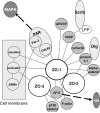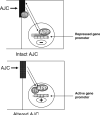Tissue polarity-dependent control of mammary epithelial homeostasis and cancer development: an epigenetic perspective
- PMID: 20101444
- PMCID: PMC2861422
- DOI: 10.1007/s10911-010-9168-y
Tissue polarity-dependent control of mammary epithelial homeostasis and cancer development: an epigenetic perspective
Abstract
The basoapical organization of monolayered epithelia is defined by the presence of hemidesmosomes at the basal cellular pole, where the cell makes contacts with the basement membrane, and tight junctions at the opposite apical pole. In the mammary gland, tight junctions seal cell-cell contacts against the lumen and separate the apical and basolateral cell membranes. This separation is critical to organize intracellular signaling pathways and the cytoskeleton. The study of the impact of the highly organized apical pole, and notably apical polarity regulators (Crb complex, Par complex, and Scrib, Dlg, Lgl proteins) and tight junction proteins on cell phenotype and gene expression has revealed an intricate relationship between apical polarity and the cell nucleus. The goal of this review is to highlight the role of the apical pole of the tissue polarity axis in the epigenetic control of tissue phenotype. The organization of the apical pole and its importance in mammary homeostasis and tumorigenesis will be emphasized before presenting how apical polarity proteins impact gene expression indirectly, by influencing signal transduction and the location of transcription regulators, and directly, by participating in chromatin-associated complexes. The relationship between apical polarity and cell nucleus organizations might explain how apical polarity proteins could switch from nuclear repressors to nuclear promoters of cancerous behavior following alterations in the apical pole. The impact of apical polarity proteins on epigenetic mechanisms of gene expression will be discussed in light of increased evidence supporting a role for apical polarity in the fate of breast neoplasms.
Figures




Similar articles
-
Cell polarity in motion: redefining mammary tissue organization through EMT and cell polarity transitions.J Mammary Gland Biol Neoplasia. 2010 Jun;15(2):149-68. doi: 10.1007/s10911-010-9180-2. Epub 2010 May 12. J Mammary Gland Biol Neoplasia. 2010. PMID: 20461450 Review.
-
Factors necessary to produce basoapical polarity in human glandular epithelium formed in conventional and high-throughput three-dimensional culture: example of the breast epithelium.BMC Biol. 2009 Nov 16;7:77. doi: 10.1186/1741-7007-7-77. BMC Biol. 2009. PMID: 19917093 Free PMC article.
-
Scribble and Discs-large direct initial assembly and positioning of adherens junctions during the establishment of apical-basal polarity.Development. 2019 Nov 21;146(22):dev180976. doi: 10.1242/dev.180976. Development. 2019. PMID: 31628110 Free PMC article.
-
The organization of tight junctions in epithelia: implications for mammary gland biology and breast tumorigenesis.J Mammary Gland Biol Neoplasia. 2003 Oct;8(4):449-62. doi: 10.1023/B:JOMG.0000017431.45314.07. J Mammary Gland Biol Neoplasia. 2003. PMID: 14985640 Free PMC article. Review.
-
The epigenetic landscape of mammary gland development and functional differentiation.J Mammary Gland Biol Neoplasia. 2010 Mar;15(1):85-100. doi: 10.1007/s10911-010-9170-4. Epub 2010 Feb 17. J Mammary Gland Biol Neoplasia. 2010. PMID: 20157770 Free PMC article. Review.
Cited by
-
Building risk-on-a-chip models to improve breast cancer risk assessment and prevention.Integr Biol (Camb). 2013 Sep;5(9):1110-8. doi: 10.1039/c3ib40053k. Integr Biol (Camb). 2013. PMID: 23681255 Free PMC article. Review.
-
Interconnected contribution of tissue morphogenesis and the nuclear protein NuMA to the DNA damage response.J Cell Sci. 2012 Jan 15;125(Pt 2):350-61. doi: 10.1242/jcs.089177. Epub 2012 Feb 13. J Cell Sci. 2012. PMID: 22331358 Free PMC article.
-
Epithelial cell differentiation regulated by MicroRNA-200a in mammary glands.PLoS One. 2013 Jun 4;8(6):e65127. doi: 10.1371/journal.pone.0065127. Print 2013. PLoS One. 2013. PMID: 23750238 Free PMC article.
-
Expression of tight junction molecules in breast carcinomas analysed by array PCR and immunohistochemistry.Pathol Oncol Res. 2012 Jul;18(3):593-606. doi: 10.1007/s12253-011-9481-9. Epub 2011 Dec 23. Pathol Oncol Res. 2012. PMID: 22193974
-
Challenges in pre-clinical testing of anti-cancer drugs in cell culture and in animal models.J Control Release. 2012 Dec 10;164(2):183-6. doi: 10.1016/j.jconrel.2012.02.031. Epub 2012 Mar 14. J Control Release. 2012. PMID: 22446384 Free PMC article. Review.
References
Publication types
MeSH terms
Grants and funding
LinkOut - more resources
Full Text Sources
Medical

